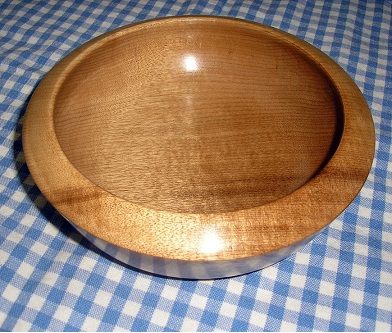My husband and I spent not quite a week in Quebec under a Road Scholar (Elder Hostel) program, September 8th thru 13th. This was our first time to use this organization. For the most part, it was a good experience. Unfortunately, we had several days with rain which detracted some from the planned stops.
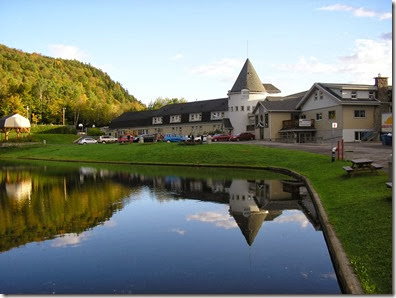
Our lodging was at the Auberge du Mont in the foothills of the Laurentian mountains. Previously a ski lodge, it now serves as a high school. However, we rarely saw the students as most of their facilities are built into the hillside and away from the main entrance. There were 31 people in our group, very interesting and enjoyable folks. The downside to staying in this beautiful place is that you are far from Old Quebec and what little free time we had was not enough to hike the trails. There is a path that goes around the small lake, and many participants would walk that early in the morning before breakfast on the days we had no rain. The trees were just starting to change color as our program ended. I see on the Road Scholar reviews that in 2012 this program met the last week of September which would have been perfect timing. Ours was the last tour for this autumn and too early for these changes.
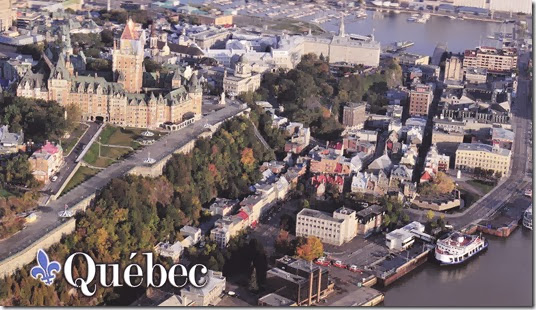
I have included a scan of a post card I bought. It gives you some idea of the lay of the land. The lower part of the Old City is on the shores of the St. Lawrence River. The upper part is dominated by the Chateau de Frontenac, the imposing hotel you can see almost anywhere in the old city. To go from the lower to the upper requires climbing steps or hilly roads or you can take the funicular for a small fee.
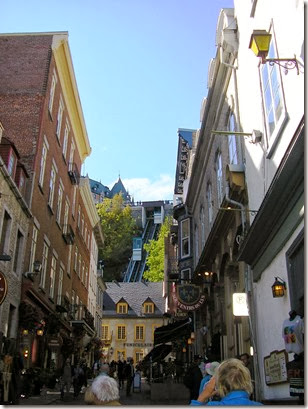
We were taken by motor coach on a tour of the city with a step-on guide. Road Scholar in this program uses a listening device that each person wears. It allowed everybody in the group to hear the guide at places where we disembarked, and to wander about taking photos in the vicinity without missing any of the historical facts being shared.
At the end of the bus tour, we walked about the Petit Champlain area of shops and restaurants. This is where the first settlers built homes in the 17th century.
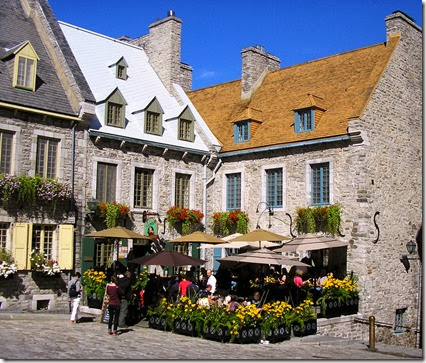
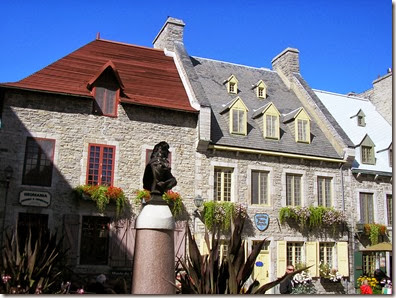

Around the corner from the main square a mural was painted incorporating important people and events in the city’s history.
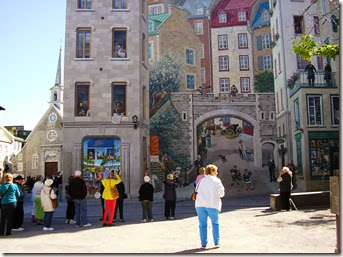
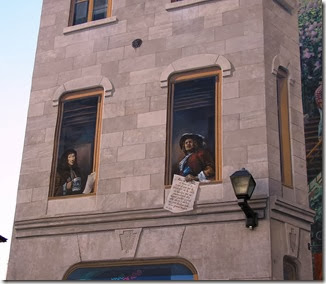
I had read from the suggested reading list Willa Cather’s Shadows on the Rock, and I could picture the characters walking around this area in the 1700s.
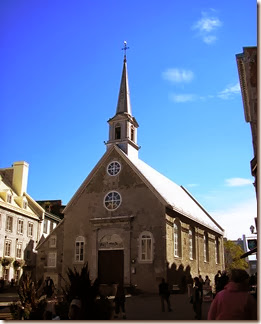
We had a few free hours to explore the city before meeting up at one of the oldest buildings in Quebec that is now a restaurant.
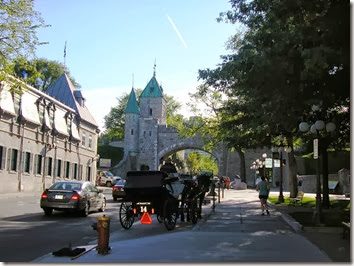
Quebec is still surrounded by its ancient walls. There has been some restoration work, and most of the old gates were redone to accommodate vehicular traffic. Above is the gate of Saint Louis. The area within the walls is fairly small and walkable as long as one doesn’t mind some hilly inclines.
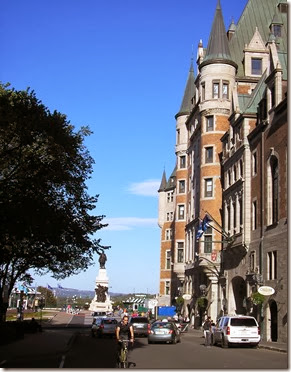
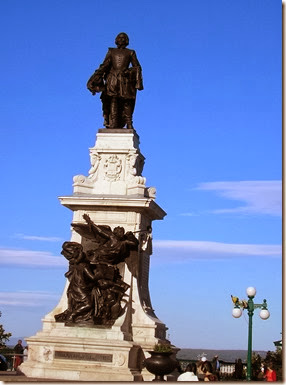
Another tribute to Champlain, the founder of the city. This is in the promenade area next to the Frontenac. Just beyond it is the boardwalk that parallels the river, except here you are above the river looking down. We could see the Rue de Petit Champlain below.
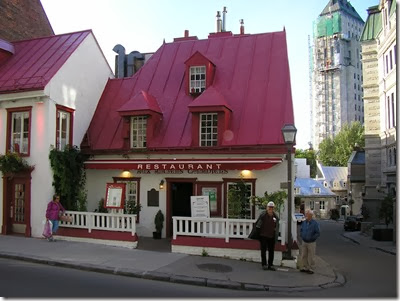
Up the block from the Frontenac on Rue Saint Louis, was our evening eating place. We had a few choices of entrees. I don’t remember the French name now, but my choice was sort of like meatloaf made from several ground meats: elk, pork, beef. The food was interesting. The other choice was fish. We had a maple dessert which was the start of the maple product tastings throughout the trip.
Our second day we started at the Museum of Civilization in the lower city. One could view as much or as little as one wanted as we were on our own until late afternoon. The Museum is a good overview of the history of Quebec. It featured much of what we had heard about during a rather long lecture the previous morning. I would have preferred less lecture, just a summary, as the museum did a better job of covering the details, and you could see the artifacts associated with various periods.
We walked around the lower city some and then had lunch in a pleasant restaurant. If it had not been raining, we could have sat out on a patio dining al fresco at several restaurants. Most of the wait staff and most of the shop keepers do speak some English. We had exchanged some US dollars at the airport for Canadian currency; however, most venues in the tourist area do accept dollars or of course for larger amounts credit cards. We rode the funiculaire after lunch to the upper city. Later that afternoon we sought out the place our bus tour guide had mentioned the previous day as a good place for poutine. Poutine is French fries with a mixture of brown gravy/sauce and cheese curds poured over the pile. We chose the bebe size (baby size), the smallest portion, and split it between the two of us. It is tasty enough, but it kind of sits like a lump in your stomach since there is so much grease/fat to digest. I could see how it would be a warm comfort food during a cold winter day.
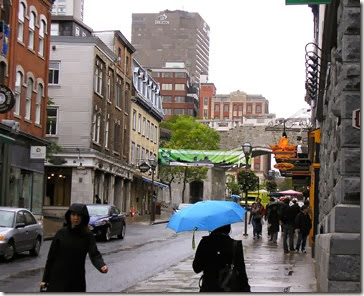
The gate in the background is Saint Jean. You can see the modern city buildings right outside of the old walls.
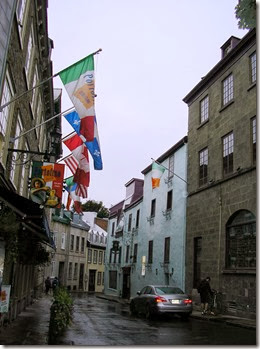
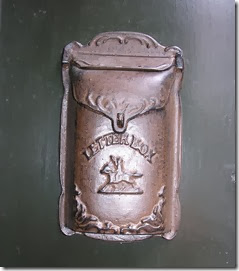
Obviously from the British era, not the French.
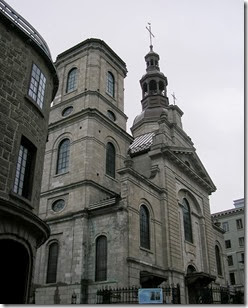
The upper city was dominated by churches (Catholic), schools/universities, and charitable health societies. In the 1960s, the provincial and national governments took over the educational and health and welfare functions. If the Church offers these, they are now under the oversight of the government. Still, the Catholic Church has enormous influence over the people, especially in the smaller towns.
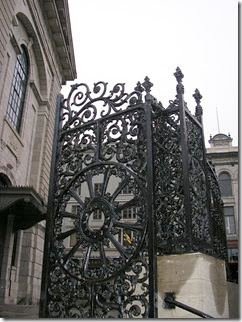

The statue in the background is Bishop Laval. He founded Laval University (which now has a modern campus in the modern city) which included a seminary. The seminary remains on the original campus within the walled city. The Bishop regulated much of the city’s moral code and laws. He was the voice of France in the New World. Though there was a governor appointed by the King of France, he was subservient to the Church.

There are many cannons on the ramparts. They are not particularly historical as they were donated by someone who collected cannons. We had no trouble finding our way back to the Museum where we had started and were to meet our bus. Wish we could have flown like a bird down from the walls. Instead we looked for the Frontenac to orient ourselves, then headed downhill to a set of steps above the Petit Champlain and the steps leading to the lower city.






Back in the lower city, we viewed the moat as we headed for the bus.


I guess they didn’t want the tourists to miss the mailbox to send their post cards.


Our host/director Jean-Pierre grew up in a small town near Quebec City. The art of wood carving was revived by 3 brothers and now there are many shops for tourists in the town. This was the shop where we stopped. I found the items in the gift shop rather crude. The pieces in the museum were better quality, though even some of them geared for a populist market.



The best sellers so to speak are based on Norman Rockwell magazine covers. You can see some of them behind the lady above. The carver who demonstrated for us was working on one of these.


There were a few more sophisticated pieces in the museum. One I really liked is below. The details were finer and the interplay of wood colors and textures interesting.

Jean-Pierre did not go on many of the fieldtrips, but this one he led. He is very proud of his town of Saint-Pierre-Port Joli. He even had the bus driver take us by the house where he grew up. We also stopped at the church which flourishes because of the gifts of the carvers.

In a back room of the church was a collection of nativity creches, many carved by the local artisans. We also met the youngest of the brothers who revived the art of wood carving and put the town on the map for tourists.
 This gentleman carved the bird podium stand; his other two brothers carved the rest of the lectern.
This gentleman carved the bird podium stand; his other two brothers carved the rest of the lectern.

The town is small; we walked through the cemetery about 2 blocks to our restaurant for the evening, first passing the tree of life carving.



The restaurant overlooked the port which now mostly docks pleasure boats. The tide was out when we started to eat, but rose by the time we left. The tides on the Saint Lawrence River have large changes in depth from low to high tide.

Jean-Pierre reminded me some of Jerry Lewis, the comedian, and had a daft sense of humor. He sponsored a House Party our third night, which took place at the Auberge, but was similar to what small town Quebecois hold in private homes to while away the time. He included several musicians of English ancestry who sang/played folksongs. It was a nice contrast to the French songs and a good reminder that the English influence while small is still present in the Province. Each Canadian Province decides which language/s to use on the road signs. In New Brunswick which has a French population, the signs have English and French. In Quebec, the signs only have French. A few people in our group who knew no French found it challenging to navigate by car.

After dinner, we visited a maple sugaring business. No pails here. There is a system of hoses attached to the taps which feed into piping which ends up where they boil the sap. The man had over 2000 trees so you can understand the more modern method. Of course, September is not sugaring time. The gift shop had samples of maple products to taste. I bought some maple sugar in a jar (to be used similar to brown sugar) and a small jar of maple syrup. The light syrup was quite bland I thought so I bought the darker-colored one. I was glad we could taste samples before we bought.
The next day we went to a rather small town known for its copper metal-working. The huge Basilica of Sainte-Anne-de-Beaupre dominates the town. The copper doors were designed and made by the local craftsmen. Saint Anne is the mother of Mary according to Catholic tradition.


From a post card.


I am sure the stained glass windows would have been beautiful in sunlight. The priest who led us on a tour pointed out often the effort to make unique motifs. For example, the marble, the tiled designs, and the carved end pieces of each pew did not duplicate one another. The first church was built in 1658 followed by 4 others. The present edifice was erected in 1923 after a fire destroyed its predecessor. Within the basilica is a shrine to Saint Anne which was visited by Pope John Paul II. One wall had crutches, braces, and other prosthetics from those who prayed for healing at the shrine.


On the lower level is the chapel of the Immaculate Conception dedicated to Mary. It had a replica of Michelangelo’s Pieta.
There were stations of the cross with bronze statues going up a hillside, but because of the rain we did not view that.
We drove to Ile d’Orleans in the middle of the Saint Lawrence River for lunch. The restaurant connected to an inn alongside the river was chosen for its view of the city of Quebec and the Laurentian mountains. Because of the weather conditions there was poor visibility. Once again, we were given a maple dessert.



The Ile d’Orleans has a few villages interspersed among fruit tree groves and vegetable and berry farms. The produce is sent to Quebec City and eaten locally. It would be especially beautiful in the spring with the blossoms on the trees. We headed across the bridge to the mainland.
Our last stop was the Chute Montmorency (Montmorency Falls). This waterfall at 70 metres is higher than Niagara.

Normally, those of our group who were able would climb the steps that wound around to the top of the falls. Our guide asked us not to do that because they were slippery from the day’s rain. Actually, the rain had pretty much stopped by then. A few people paid to take an aerial car to the top, but most of us stayed on the bus which took a road to the top.

At one time this waterfall was used to generate electricity for the surrounding area. There was a pedestrian/bike bridge and several lookout points.


As we gathered back at the restaurant/gift shop housed in a former residence, the sun broke out for the first time that day.



We returned to the Auberge where we had supper and a graduation ceremony complete with a diploma and kiss from Jean-Pierre. We also received a print of the group photo that had been taken at the beginning of the week; a copy would be added to the scrapbook in the meeting room.
The exposure to the culture and to the countryside was possible through this program. While going from site to site via the bus we were able to discern the historical land pattern. When the noblemen who received land grants from the king subdivided their parcels, they found the geography of the land and the requirements of the buyers necessitated long thin strips. The thick forests with their dangers of wild animals and hostile Indians and hilly or mountainous terrain were not easily traversed. Land owners needed access to the river to transport goods and themselves. To ensure river access to as many people as possible, the strips of land started at the river and went deep into the countryside but were not very wide across. When flying on a small prop plane from Quebec to Montreal to catch our flight home, my husband and I could see by the demarcations of fences, windbreaks or hedgerows the boundaries of these narrow strips.
Because we ate most of our meals as a group at the Auberge or in restaurants, we had plenty of time to chat with our fellow participants. I probably would not repeat this trip, but might return to Vieux-Quebec to enjoy walking thru the city and eating on the patios. It is a touch of Europe without the overseas trip.
